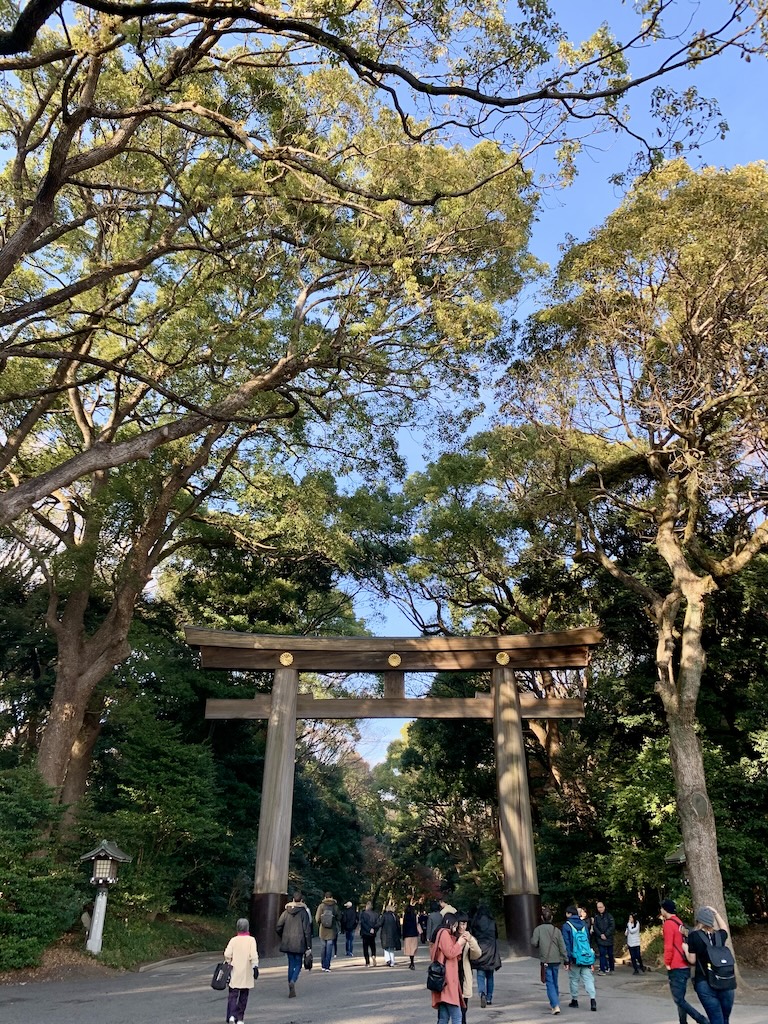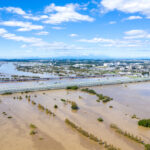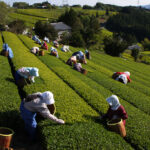The term “shinrin-yoku,” or forest bathing, was coined in Japan almost forty years ago, in 1982. The then director-general of the Forestry Agency, Akiyama Tomohide, promoted the concept in the following terms:
“Japan is one of the leading ‘forest-nations’ of the world, so we should make use of our forests for health and recuperation. Forests have a special antimicrobial power, and being in the forest makes our bodies healthy.”
Akiyama’s assertion that forests have an antimicrobial power was a reference to phytoncides. In 1928, Dr. Boris P. Tokin of Leningrad University discovered that coniferous trees release substances with antimicrobial properties to protect themselves from harmful insects and germs. He named these substances phytoncides (“phyton” means “plant” and “cide” means “exterminate”). Tokin was also the first person to demonstrate scientifically that phytoncides, or wood’s essential oils, have a relaxing and calming effect on humans.
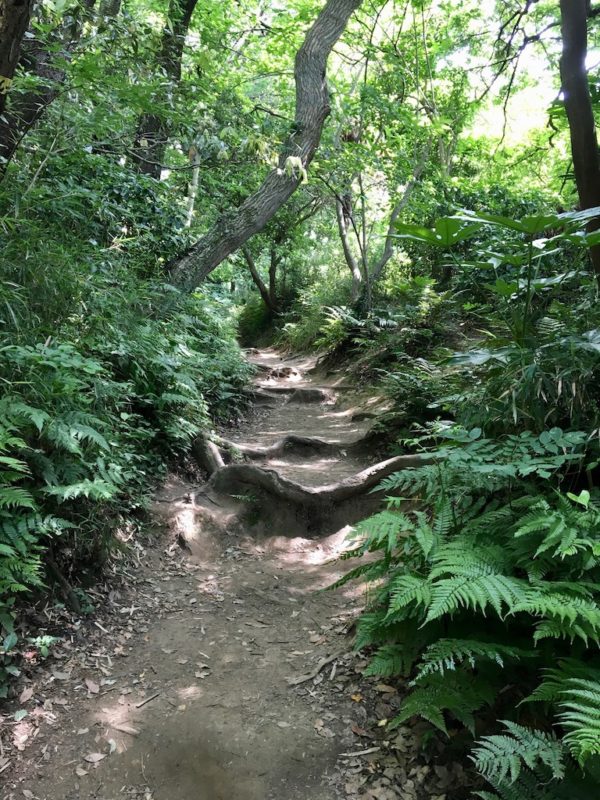
Feel the phytoncides: A section of the Daibutsu Hiking Course in Kamakura
THE JAPAN JOURNAL
Based on this research into phytoncides, shinrin-yoku aims to promote mental and physical health and healing through practices such as breathing forest air and encountering trees while experiencing the benefits of the forest with all five senses. The term “shinrin-yoku” refers to the practice of taking in or, literally, “bathing” in forest air, just as visitors to a hot spring bathe in mineral-rich water for mental and physical recuperation.
Shinrin-yoku research has covered a variety of forest bathing opportunities, from walks in local parks and woods, to mountain climbing and camping, even visiting the zoo, and positive health effects have been found across research results. For example, it has been shown that, in terms of physical effects, an approximately 20-minute session of forest bathing can reduce the level of stress hormones, increase parasympathetic nerve activity and reduce sympathetic nerve activity. Meanwhile, in terms of mental effects, such a session can increase feelings of positivity and recovery. What’s more, it has been found that during extended three-day-two-night shinrin-yoku sessions, the body’s immune cells (natural killer cells) are activated, boosting the body’s immunity to illness. Research results also show that the effects of shinrin-yoku are greater for those who experience chronic stress.
Bases for Forest Bathing
In the autumn of 1982, the year that Akiyama coined the term “shinrin-yoku,” a forest bathing conference was held in the Akasawa Natural Recreation Forest in Agematsu Town, Nagano Prefecture, considered one of Japan’s “three forests of outstanding beauty.” The conference served to spread interest in shinrin-yoku throughout Japan, and the Akasawa Forest has thus became known as the birthplace of forest bathing. The Akasawa Forest includes natural woodland with Kiso hinoki cypress trees that are over 300 years old. Every twenty years, timber from the forest is used for the rebuilding of the Ise Jingu grand shrine in Ise, Mie Prefecture. The periodic rebuilding, known as “Shikinen Sengu,” has been conducted without break for 1,300 years, and entails the transfer of the shrine’s deity from the previous “divine palace” to the newly constructed one. For this reason, the Akasawa Forest has been carefully preserved.
To promote shinrin-yoku, from 1998 the Forestry Agency has registered a number of state-owned forests across Japan as official Recreation Forests. The Akasawa Forest is just one of around 1,000 forests accredited so far, accounting for some 380,000 hectares of land. The website linked above is a rich source of information for anyone looking for a nearby forested destination.
Together with the National Land Afforestation Promotion Organization and the Japan Wellness Foundation, the Forestry Agency has established a Forest Bathing Executive Committee. This organization came up with the idea of establishing “Bases for Forest Therapy.” These would be founded based on the results of physiological experiments into the healing effects of forests while promoting regional development.
One of the first such bases, registered in 2006, was the Akasawa Forest. In total, six bases were registered at that time: Akasawa Forest, Oguni Town in Yamagata Prefecture, Iiyama City and Shinano Town in Nagano Prefecture, Yamaguchi City in Yamaguchi Prefecture, and Hinokage Town in Miyazaki Prefecture. They were selected from a large number of candidates on the grounds of physiological experiment results, provision of accommodation and other facilities, location and ease of access, and vision for the future. To date, sixty-three Bases for Forest Therapy have been accredited, right across Japan, from Hokkaido to Okinawa.
As well as a forest therapy “experience center,” the Akasawa Forest base contains research facilities and a reference library, a forest railway, and eight shinrin-yoku walking courses ranging from a forty-minute 1.5-km walk to a two-hour 3.5-km walk. The base is open from late April to early November, and each year receives more than 120,000 visitors from Japan and abroad.
Greening the Cities
Japan is blessed with abundant green space, and 67% of Japan’s land is covered in forest. Among the famous forests of Japan are those in the World Heritage Sites of Mount Fuji and Shirakami-Sanchi; Yakushima, an island known for its very old-growth cryptomeria trees; and the sacred sites and pilgrimage routes in the Kii mountain range. World Heritage Sites such as Kyoto and Nara, Hiraizumi, and Nikko also exist alongside abundant forest.
On the other hand, Japan’s cities are concentrated on the plains, and green space there is limited.
“Green covering ratio” is an indicator that shows how much of an area is occupied by greenery such as trees and grassy land, or farmland. In 2013, Tokyo’s green and water covering ratio was 50.5%. Although the Tama region to the west of Tokyo has plenty of nature and a 67.1% green ratio, the twenty-three wards that make up Tokyo’s center have a ratio of just 19.8%.
To increase the amount of greenery in the city center, the Tokyo Metropolitan Government (TMG) has been moving forward with a range of initiatives including the building of parks, green areas and green roadsides; the greening of schools, hospitals and other public facilities; and the greening of outdoor spaces and roofs as part of private-sector residential developments. In August 2023 TMG launched a new long-term greenery project called “Tokyo Green Biz,” which aims to enhance, in cooperation with Tokyo citizens, the value of Tokyo‘s greenery by working together with various business (biz) entities, According to date published in the Tokyo Green Biz launch literature, the green coverage ratio in the central Chuo, Chiyoda and Minato Wards has increased by one or two percent in the last ten or so years.
In recent years, no major urban development has been able to proceed without consideration being given to greening, whether it be greening on the face of the buildings, their roofs or their immediate surroundings.
Since it opened for business in April 2003, the Roppongi Hills development in Tokyo’s Minato Ward has been visited by over 40 million people each year. The “city within a city” occupies an area of about 11.6 hectares and consists of a district of offices, residential and commercial facilities, cultural facilities, hotels, a cinema complex and broadcasting center—all clustered together in a group of skyscrapers. Due to this development, the flow of pedestrians and the arterial roads in the surrounding area have been upgraded, improving the traffic environment in the larger area. Making use of the steep terrain, elevators, escalators and other installations have eliminated the height differences, creating safe and comfortable pedestrian zones.
Roppongi Hills also features an abundance of greenery, with 68,000 trees planted and about 1 ha more green space than there was before the development. In addition, Mori Building signed the “Leadership Declaration for Business and Biodiversity initiative” at the 9th meeting of the Conference of the Parties to the UN Convention on Biological Diversity in 2008 and is expanding the green environment for existing wildlife. Mori Building took advice from experts and extended the green environment so that existing wildlife could continue to live there. One physical demonstration of this concept is the Mori Garden in Roppongi Hills. This Japanese garden has a path around a central pond, a style that harks back to the mansions of the feudal lords that were located here in the Edo period (1603–1867). Throughout the year, many people visit the Mori Garden in search of relaxation.
Tokyo may only have a green and water covering ratio of 19%, but there are a number of locations with dense woodland, such as the rich woodland in the Imperial Palace, the Akasaka Detached Palace, the Shinjuku Imperial Garden, Meiji Jingu shrine and its outer gardens, Yoyogi Park and Ueno Park. According to the results of one study, people feel that an area is rich in greenery when the grass and trees cover 25% of their view from the street. If this greenery is connected to that in urban redevelopment projects, the amount of visible greenery extends even further.
In 2005, the Ministry of Land, Infrastructure, Transport and Tourism (MLIT) conducted a social experiment survey at Roppongi Hills into the correlation between the amount of urban greenery and psychological effects. According to the results of that survey, as the green covering ratio increases, so do psychological effects such as improved feelings of richness, calm and freshness. Regarding the greening of high-rise buildings in large cities, those who replied to the survey reported results such as a feeling of refreshment (71.5%), comfort (62.5%) and an alleviation of tiredness (60.6%). At the same time, around 90% of respondents hoped for the greening of roof space to progress further.
Also, according to a 2014 survey by the National Institute for Land and Infrastructure Management, MLIT, “The Roadside Trees of Japan Ⅶ,” the number of trees (tall trees) planted on Japan’s roadsides increased from 284,620 in 1954 to 1,779,805 in 1982, 6,208,191 in 1997 and 6,749,810 in 2012. The most common roadside trees planted in Japan included ginkgo, ornamental cherry and saw-leaf zelkova. In many cases, beautiful and verdant roadside trees have become symbols of their cities, such as ginkgo in Sapporo and Osaka’s Midosuji, and zelkova in Sendai and Fukuoka. For residents too, roadside trees are an attractive feature of their cities.
“Young Green Leaves”
How awe-inspiring!
On the green leaves, the young leaves
The light of the sun
The poet Matsuo Basho (1644–1694) wrote the haiku above (trans. Donald Keene) at sacred Mount Nikko, which since the time of the Buddhist monk Kukai (774–835) had been a center of mountain worship (see box article on Nikko). Much of the woodland in Japan today however is artificially made by humans who have ventured into the mountains. For example, the cedar-lined approaches to Tosho-gu shrine in Nikko were originally planted almost 400 years ago in honor of Tokugawa Ieyasu (1543–1616), the founder of the Edo Shogunate, a mausoleum for whom is situated there.
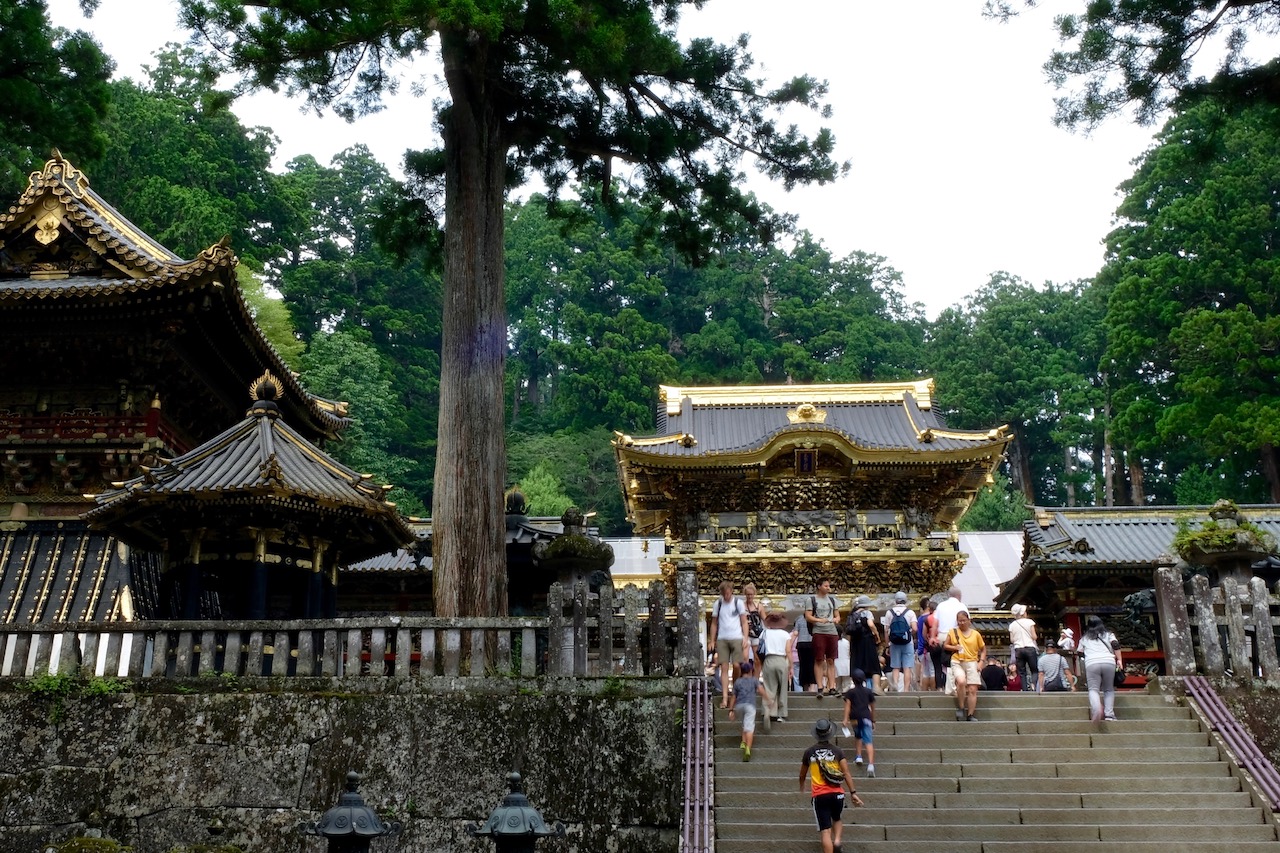
The ornate buildings of Nikko’s Tosho-gu shrine are surrounded by mighty cedar trees.
TJJ PHOTO
The rich woodland that surrounds Meiji Jingu shrine in Tokyo is likewise planted, a process which began in 1915 in honor of the Emperor Meiji (1852–1912). The shrine, itself a symbol of the Japanese worship of nature, was deliberately located at the center of a sacred forest. The stately calm of Meiji Jingu makes it popular as an urban oasis and it has many visitors throughout the year. Lately it has been added to the itineraries of many foreign tourists, and has become one of Tokyo’s most popular sightseeing locations. For nearby office workers too, the woodland of Meiji Jingu provides a chance to straighten their posture as they pass under the huge torii gate, then enjoy a refreshing break amid rich greenery. The respite from the stresses of everyday life which the shrine’s grounds offer makes it enduringly popular.
There is an architect who is working to bring these effects into the office itself. He is Fujimoto Sosuke, better known in Japan and abroad as Sou Fujimoto. Fujimoto recreates in the office elements typically found in shrines and temples, such as stone paths and greenery. By controlling the play of light, he deliberately produces a harmony between tension and relaxation, designing spaces that increase concentration. An important element of that is the aforementioned green covering ratio. When the kind of vegetation that raises the green covering ratio interrupts the surrounding field of vision, it produces a relaxation effect.
Right now, outside my office, cherry blossom trees scatter petals and are thick with leaves, while the foliage on a line of gingko trees is starting to fill out. In mid-May the cherry-blossom front will finally reach Hokkaido and Japan will enter the season of “young green leaves.” The mountains will sparkle with the young leaves of early summer, and it will be the time when forests overflow with verdant energy. A season is coming that is replete with the fascination of Japan’s forests… and so much more than just cherry blossom or autumn leaves.
Mizuno Tetsu is a freelance writer.

